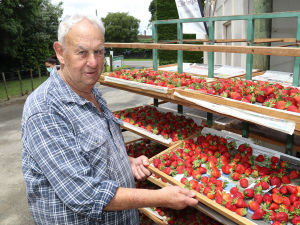Late start but strong season ahead for New Zealand strawberries
Despite a late and unfavourable start, this year’s strawberry crop is expected to be bountiful for producer and consumer alike.
 Horowhenua strawberry grower Kevin Donovan drying out strawberries in late December, which had just been picked.
Horowhenua strawberry grower Kevin Donovan drying out strawberries in late December, which had just been picked.
It will take between six to eight months for commercial growers in the Horowhenua region to fully recover from the disastrous heavy rains that hit the region in the weeks leading up to Christmas.
In the space of 10 days, more than 300mm of rain fell in the area - three times the usual December rainfall total. Locals say they have never seen anything like this before.
The rain came at a critical time as vegetable and strawberry growers were trying to supply supermarkets for the Christmas trade. Many growers lost crops at this time.
President of the Tararua Vegetable Association, whose members include those in Horowhenua, says he's never seen anything like the rain that fell in December. Terry Olsen told Hort News that it's not uncommon to have a wet December. He says it's still too hard to estimate the exact cost of the rains.
Olsen is a potato grower and talking to other growers says it would seem that between 10 and 15% of the crop has been lost so far.
"the thing is that sometimes you think you have a reasonable potato crop but when you come to harvest and process them, many aren't fit for purpose," he told Hort News.
"So, there is always an impact that is far wider than you first visualise. You can't look at potato crop on the surface and say it's okay - unlike some vegetables. It's not until they're harvested that you get the complete picture."
Olsen says losing crops is one thing, but with the amount of rain they've had, the paddocks were so wet it was impossible to get machinery on to them to replant crops, fertilise and spray.
He says the rain is hard on crops, soils and people. The problem is compounded by staff shortages facing contractors, because insufficient skilled overseas workers are being allowed into the country. Olsenn says contractors are stretched to the limit.
He says the other problem in Horowhenua has been the lack of sunshine.
"Strawberry growers have been particularly impacted by this because their crops could not ripe," Olsen explains. "Prior to Christmas, there were a lot of dull overcast days and only recenly have we seen hot sunny days."
Olsen is hoping it gets to a stage when growers in the region can get a smile back on their faces.
Greenlea Premier Meats managing director Anthony (Tony) Egan says receiving the officer of the New Zealand Order of Merit (ONZM) honour has been humbling.
Waikato dairy farmer Neil Bateup, made a companion of the New Zealand Order of Merit (CNZM) in the New Year 2026 Honours list, says he’s grateful for the award.
Another Australian state has given the green light to virtual fencing, opening another market for Kiwi company Halter.
Farmer interest continues to grow as a Massey University research project to determine the benefits or otherwise of the self-shedding Wiltshire sheep is underway. The project is five years in and has two more years to go. It was done mainly in the light of low wool prices and the cost of shearing. Peter Burke recently went along to the annual field day held Massey's Riverside farm in the Wairarapa.
Applications are now open for the 2026 NZI Rural Women Business Awards, set to be held at Parliament on 23 July.
Ravensdown has announced a collaboration with Kiwi icon, Footrot Flats in an effort to bring humour, heart, and connection to the forefront of the farming sector.

OPINION: The release of the Natural Environment Bill and Planning Bill to replace the Resource Management Act is a red-letter day…
OPINION: Federated Farmers has launched a new campaign, swapping ‘The Twelve Days of Christmas’ for ‘The Twelve Pests of Christmas’ to…